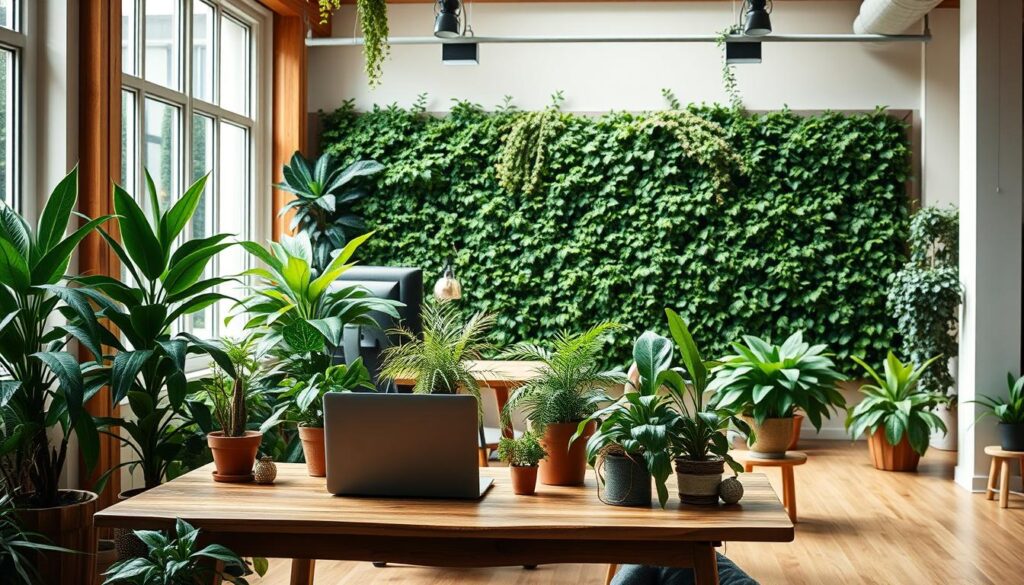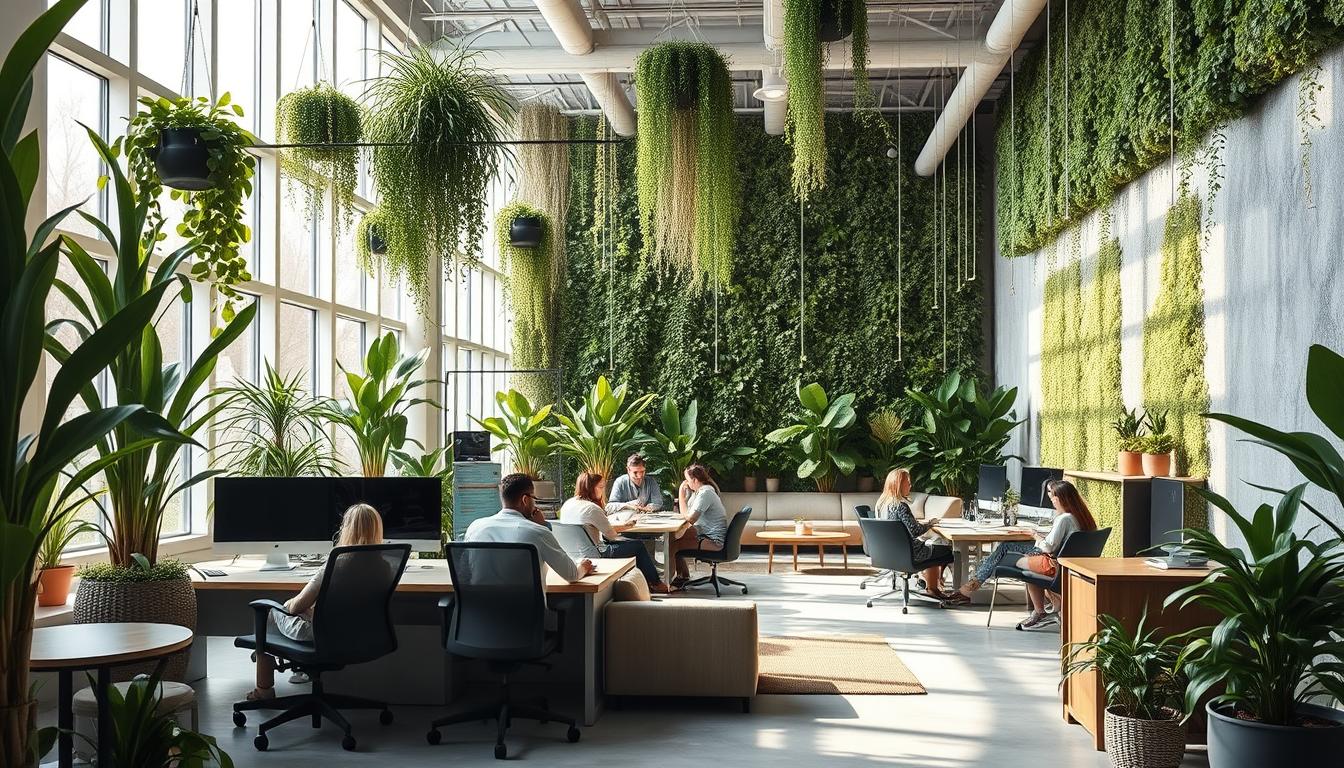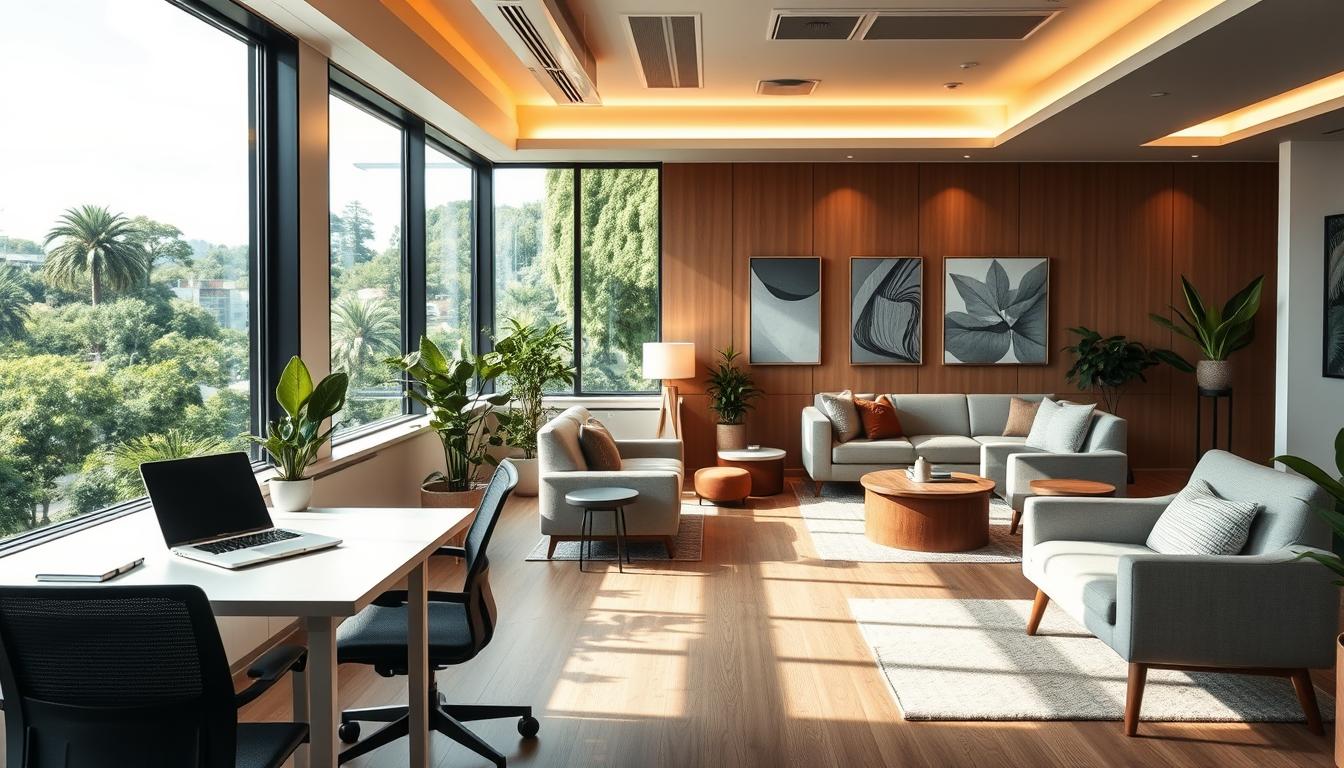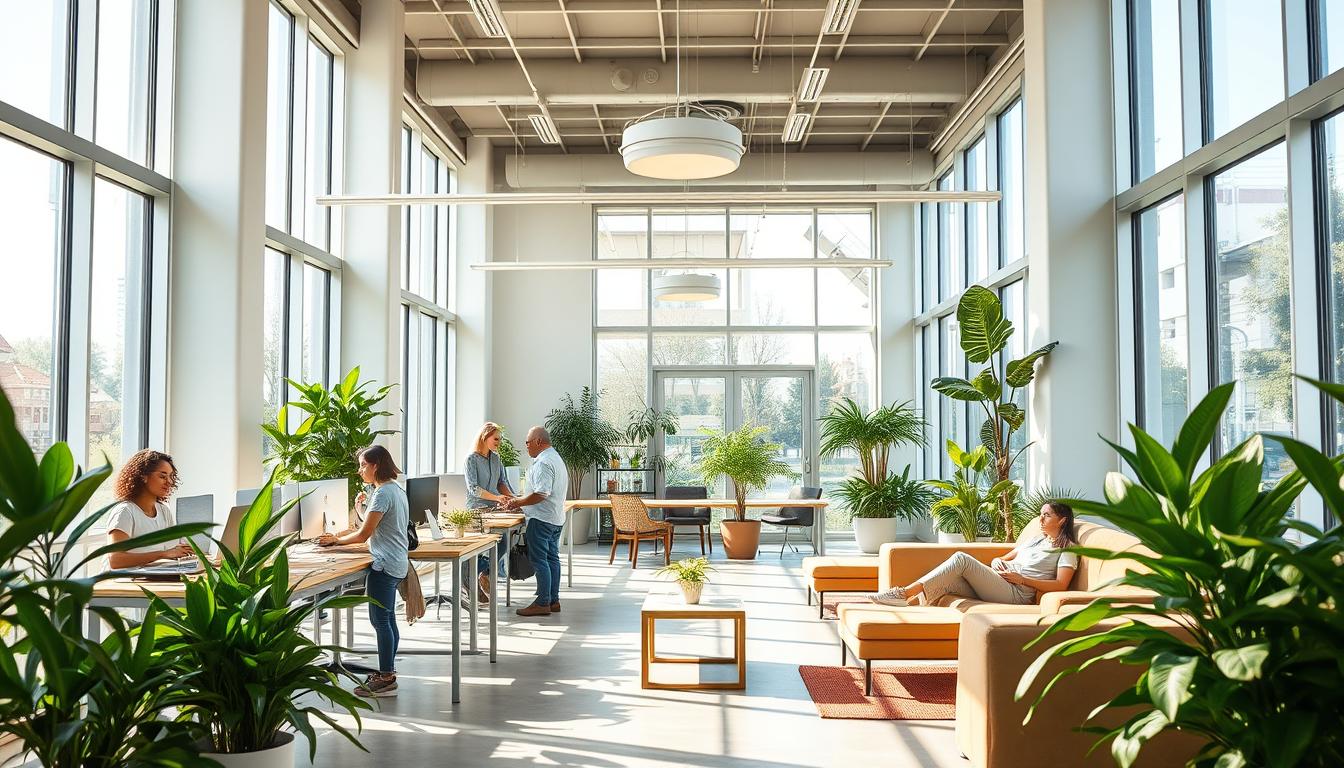In today’s world, everything moves fast. Often, we forget how much we need peace. Biophilic design brings nature into workspaces, helping us reconnect with our surroundings. It boosts productivity and makes people feel better. Nature inside helps reduce stress and helps us focus.
Looking at how biophilia improves work, we see big benefits. Adding natural elements to the office makes employees happier and work better. It’s more than just looking nice. It’s about making workspaces healthier and more efficient.
The Significance of Biophilic Design in Today’s Workspaces
Biophilic design plays a key role in today’s workspaces. It helps battle the downsides of city life and being sedentary. By adding nature to our work environments, we create spaces that improve focus and health.
Adding things like plants, sunlight, and eco-friendly materials makes workspaces where creativity flows. It forms a bond between people and nature that boosts happiness and how much they get done. This shows how nature in the office can change our work life.
As work styles change, companies want spaces that help people feel and work better. There’s a big push for office designs that embrace biophilic elements. Now, it’s a major part of designing modern offices.

The Science Behind Biophilic Design
Edward O. Wilson introduced the biophilia hypothesis. It suggests people naturally want to connect with nature. This bond helps improve our health and mind, making us more productive. Studies show that nature can boost happiness at work, an important aspect of modern design.
Understanding the Biophilia Hypothesis
The biophilia hypothesis says connecting with nature is good for our minds. Research proves that nature makes us feel better and less stressed. So, workspaces are now designed to include elements of nature. This fits with how humans have evolved, meeting deep-rooted needs.
Impact of Nature on Mood and Productivity
Research has explored how nature helps us work better. Adding plants, natural light, and views of the outdoors to workspaces can lower stress and improve thinking. Benefits include:
- Improved concentration and focus.
- Lower levels of anxiety and fatigue.
- Increased creativity and problem-solving skills.
Offices with these natural elements change how employees interact. They create a healthier, more lively workplace. This shows how strongly the biophilia hypothesis affects our lives.
Key Principles of Biophilic Design
Biophilic design is key for better workspaces, boosting productivity and well-being. This approach brings people closer to nature, whether directly or indirectly. By applying these ideas, offices become more inviting and inspirational.
Direct Experience of Nature
Live plants, sunlight, and water in the workspace let people experience nature firsthand. These elements make the office feel more inviting, helping employees to relax, focus, and be more creative.
Indirect Experience of Nature
Even without direct contact, nature’s essence can be felt. Using natural materials and colors makes the workplace calming, like the outdoors. This approach creates a peaceful space that reminds us of the beauty of nature.
Spatial Configuration
Layouts that encourage moving, meeting, and unwinding are vital. They make work areas flexible and meet employee needs better. Good design also boosts teamwork and well-being, making everyone feel more connected and productive.
Practical Tips for Implementing Biophilic Design
Adding biophilic design features can make offices better. It makes workspaces look nicer and helps everyone work better and feel great. Here are some ideas to try:
Maximize Natural Light in the Workspace
Bringing in more natural light makes workspaces brighter and more lively. To do this, you can:
- Move desks and chairs so they get the most sunlight.
- Put in lighting that changes with the daylight.
- Use mirrors and light colors to spread light around the room.
Incorporate Greenery for Enhanced Focus
Adding plants to your office makes it look nice and clean the air. This helps everyone concentrate better. You can add:
- Easy-care plants like snake plants or pothos.
- Wall gardens that don’t take up much space.
- Small plants for desks that people can enjoy up close.
Utilize Natural Materials in Design
Using things made from nature can make an office feel welcoming. You should think about:
- Wood for furniture and decorations to add a natural feel.
- Stone touches for a bit of the outdoors inside.
- Natural fiber fabrics for curtains and furniture covers.
Productivity Enhancement via Biofilia
Adding nature to workspaces boosts productivity significantly. When companies use biophilic design, it helps employees feel and work better. Natural elements reduce stress, improve moods, and focus, creating a better workplace.
Benefits of Incorporating Nature into Workspaces
Natural features in offices bring many benefits:
- Reduction in stress levels through calming green spaces.
- Increased creativity inspired by natural elements.
- Enhanced concentration aided by natural lighting.
- Better air quality resulting from indoor plants.
Positive Effects on Employee Well-being
Connecting with nature greatly boosts employee happiness and job satisfaction:
- Lower turnover rates owing to a more enjoyable work atmosphere.
- Boosted engagement levels as employees feel more connected to their environment.
- Overall health benefits through reduced anxiety and enhancing mental clarity.
How Anchorpoint Interiors Applies Biophilic Design
Anchorpoint Interiors excels in creating custom office designs that embrace biophilic elements. They understand what their clients need. This lets them craft spaces that look great but also boost employee health.
Customised Design Solutions for Clients
Anchorpoint Interiors knows each office space is different. So, they offer designs that match every client’s needs. These designs feature:
- Natural materials that bring peace
- Green plants that clean the air and help people concentrate
- Elements designed to let in plenty of sunlight
With this approach, they make sure the client’s dream becomes a reality. They also make sure it includes key biophilic parts.
Innovative Practices in Biophilic Design
Anchorpoint Interiors uses new methods in their biophilic designs. They do things like:
- Apply tech to mimic nature
- Add water features for a peaceful vibe
- Create flexible areas that spur creativity and teamwork
This keeps them at the forefront of design, making spaces that really connect with the natural world.
Collaborative Efforts in Biophilic Design
Successful biophilic design needs teamwork. Working with specialists makes the design both pretty and functional. Anchorpoint Interiors is great at this, thanks to their teamwork with plant suppliers. They pick the best plants for offices, making workspaces nicer.
It’s also key to work with lighting experts. They help bring in natural light, making offices energy-smart and comfy for all. By joining forces, companies can make spaces that are in tune with nature. This leads to happier and healthier employees.
Challenges of Integrating Biophilic Design into Workspaces
Adding biophilic design to current workspaces faces many challenges. One big hurdle is structural barriers. These can block adding plants, water features, or sunlight. Many older office buildings lack the setup needed for these natural elements.
Money issues also pop up. Choosing sustainable materials may cost more than traditional ones. Companies often have to rethink their spending. This can make it hard to create a real biophilic environment.
Another problem is that some people don’t know the perks of biophilic design. Without support from leaders, it’s tough to welcome nature into workspaces. Teaching everyone about biophilic design’s benefits can help.
Future Trends in Biophilic Design
The landscape of biophilic design is evolving, and it’s getting more exciting with technology. More companies are seeing the value in designing workspaces with nature in mind. These spaces don’t just look good; they make employees feel better too.
Looking ahead, we’ll see a beautiful mix of the natural world and human-made elements. This mix will change how we build and care for our spaces. It’s all about bringing the outdoors inside in a smart way.
Incorporating Technology with Nature
Technology will be a game-changer for biophilic design. It will let us control things like light, warmth, and air in the workplace. This can make offices better for work and health.
With new tech, nature in the office won’t just be for show. It will help make workspaces places where people really want to be. This can boost productivity and wellness.
Sustainable Practices in Workspace Design
The future will also highlight green practices in office design. Choosing eco-friendly materials and smart energy use will be key. Designers will focus on making spaces that are kind to the earth and great for people.
This move towards sustainability will show companies’ dedication to doing right by the planet. It’s about more than just looking green. It’s about truly connecting with nature and caring for our world.
Measuring the Impact of Biophilic Design on Productivity
To measure how biophilic design affects productivity, we look at several key factors. These include how engaged employees are and how well the workplace performs. It’s important for organizations to keep an eye on specific KPIs in office design. This helps them see how adding elements of nature benefits the work environment.
Key Performance Indicators to Track
There are several KPIs to watch when assessing biophilic design’s impact on productivity:
- Employee engagement levels
- Absenteeism rates
- Overall productivity metrics
- Quality of work produced
- Team collaboration rates
Employee Feedback and Satisfaction Surveys
Gauging productivity also requires looking at employee satisfaction. Surveys and feedback give insights into how staff feel about nature in their workspace. Understanding these feelings helps firms tweak their offices. They can make them better suited to what employees like and need.
Conclusion
Biophilic design is key in boosting workplace productivity and making employees feel good. Adding natural elements to the office can majorly lift employee spirits. This makes a place where creativity and teamwork blossom.
Nature in the office does more than just look nice; it builds a better company culture. It cares for the mental and emotional well-being of workers. Feeling connected to nature can brighten moods and help businesses do better by making employees work better.
Using design to increase productivity is essential, not just a fad. Companies that embrace biophilic design make inspiring spaces. These spaces have a lasting effect on their teams and deepen the bond between workers and their workplaces.



